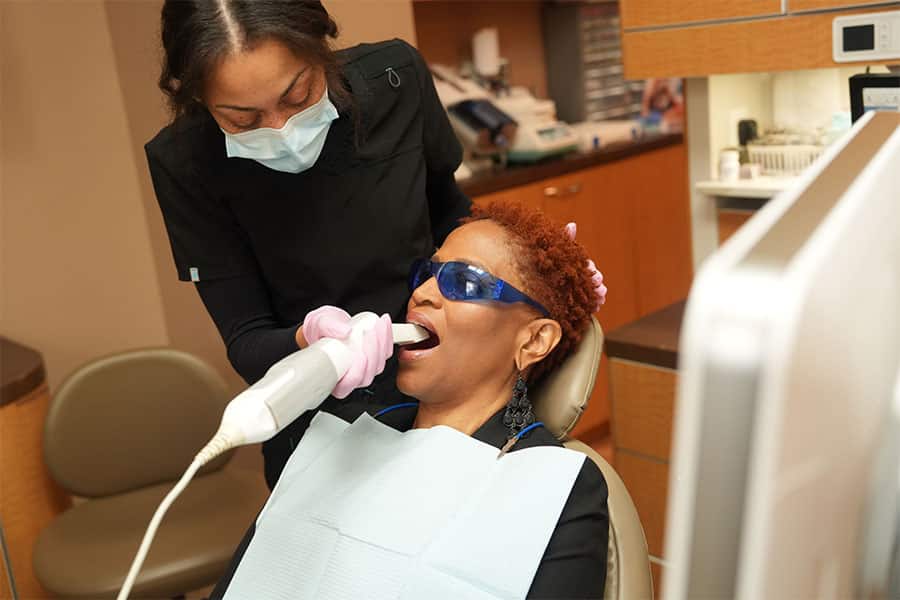- New Patient Special
- Serving the Atlanta Metro and Midtown Area Since 1982
- (404) 872-7755
At Atlanta Dental Center, Dr. Francisco Garcia offers specialized root canal therapy designed to save and preserve your damaged teeth. With over 25 years of experience, Dr. Garcia is a leading expert in root canal procedures, ensuring you receive top-notch care in Atlanta.

Root canal therapy becomes essential when the pulp of your tooth becomes infected or severely damaged. Our mission is to restore your tooth’s health and functionality while prioritizing your comfort throughout the process. Dr. Francisco Garcia, a highly skilled general dentist, has successfully performed hundreds of root canals. He can accurately determine whether this treatment is appropriate for your condition.
We make your comfort a top priority during the root canal procedure. Our advanced facility features state-of-the-art technology, and Dr. Garcia ensures the process is as pain-free as possible. To enhance your experience, enjoy amenities such as cozy blankets, soothing music, or even a movie.

A root canal is performed to save a tooth that is severely damaged or infected. Common reasons for needing a root canal include:
Symptoms that may indicate you need a root canal include:

If you’re seeking a root canal specialist in Atlanta, Dr. Francisco Garcia combines extensive experience with a commitment to patient comfort and high-quality care. Whether you’re dealing with a severe tooth infection or need routine root canal therapy, we are here to assist you.
For expert root canal therapy in Atlanta, call us at +1 (404) 872-7755 or request an appointment online. Our team is ready to provide you with exceptional care.

Satisfied Client
"I had tiny cracks in my front two teeth. The doctor was so friendly and accommodating throughout the whole process. She wanted my teeth to look perfect—up to my standards. The staff fit me in when it was convenient for me. My teeth look and feel amazing now! I have more confidence, a brighter smile and more ease of eating.”
Satisfied Client
"I am very impressed with the treatment and the follow-up and care after the work is done. What I liked best was the beautiful smile after all the work was done. I have a trouble-free smile that has brought me numerous compliments and is very functional. It has basically given more confidence and I can eat most anything I want to eat.”
Satisfied Client
"If I ever moved, I think I would fly here for my dentistry! It has a lot to do with how expert the dentists are. They do the injection in the exact area. Unlike in the past, people can’t even tell when I have been to the dentist as my lip where I had the injection looks completely normal"
Satisfied Client
"I had a terrible toothache over the weekend and called Atlanta Dental Center first thing Monday morning. They got me in right away, and the dentist was so gentle and thorough. I left pain-free and very grateful!"
Satisfied Client
“I was always self-conscious about my gummy smile, but after just one laser treatment, my confidence soared. The procedure was quick and painless, the results are fantastic!”
Satisfied Client
“The laser gum treatment at Atlanta Dental Center was a game-changer for me. No pain, no stitches, and I love my new smile!”
Satisfied Client
"I used to wake up feeling exhausted every morning, no matter how long I slept. After getting my oral appliance from Atlanta Dental Center, I’m finally getting the restful sleep I need. I feel more energetic and alert during the day, and my snoring has stopped completely. Thank you!"
Satisfied Client
"I had a terrible toothache over the weekend and called Atlanta Dental Center first thing Monday morning. They got me in right away, and the dentist was so gentle and thorough. I left pain-free and very grateful!"
Satisfied Client
"When my son knocked out his front tooth during a soccer game, we rushed to Atlanta Dental Center. The team was amazing—they reinserted the tooth, and my son is doing great now. I can’t thank them enough!"
Satisfied Client
"Fastbraces® changed my life—I saw results in just 4 months! I couldn’t be happier with my new smile."
Satisfied Client

Send us your email to stay up to date with our latest news and special offers
© 2024 Atlanta Dental Center. All rights reserved.

"I needed to replace three teeth and was told that the best way to go would be with dental implants. At first I thought, ‘they’re going to drill into my jawbone.’ But actually it was so precise that it ended up being a quick and very comfortable procedure."